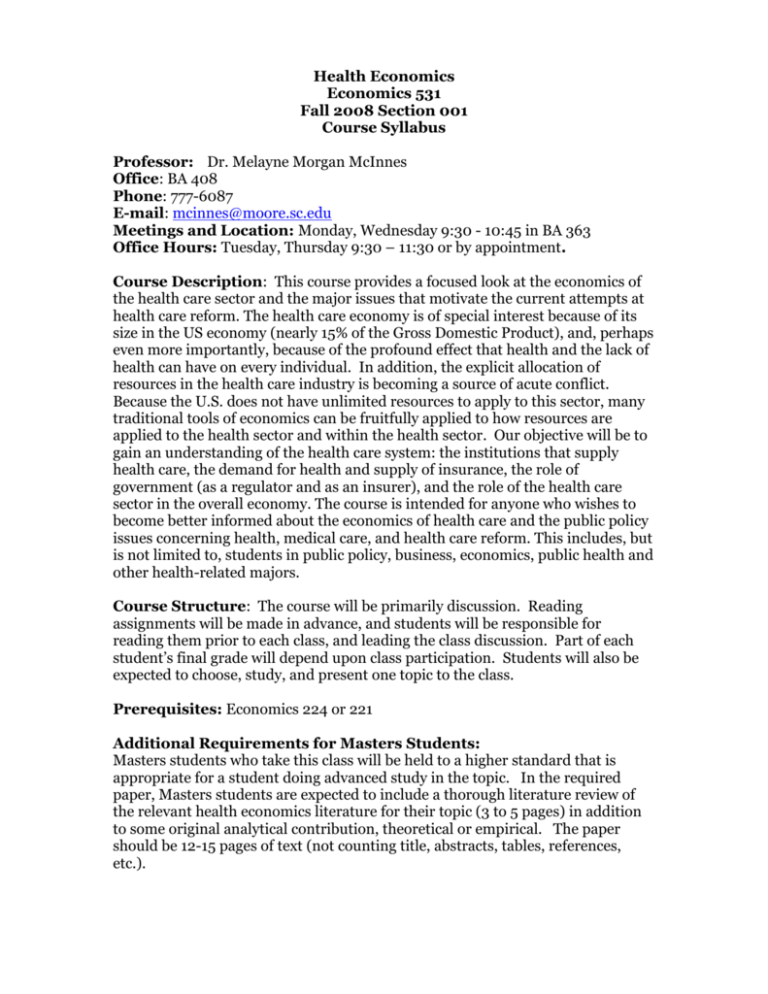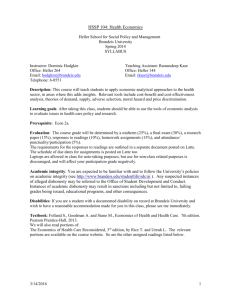Health Economics
advertisement

Health Economics Economics 531 Fall 2008 Section 001 Course Syllabus Professor: Dr. Melayne Morgan McInnes Office: BA 408 Phone: 777-6087 E-mail: mcinnes@moore.sc.edu Meetings and Location: Monday, Wednesday 9:30 - 10:45 in BA 363 Office Hours: Tuesday, Thursday 9:30 – 11:30 or by appointment. Course Description: This course provides a focused look at the economics of the health care sector and the major issues that motivate the current attempts at health care reform. The health care economy is of special interest because of its size in the US economy (nearly 15% of the Gross Domestic Product), and, perhaps even more importantly, because of the profound effect that health and the lack of health can have on every individual. In addition, the explicit allocation of resources in the health care industry is becoming a source of acute conflict. Because the U.S. does not have unlimited resources to apply to this sector, many traditional tools of economics can be fruitfully applied to how resources are applied to the health sector and within the health sector. Our objective will be to gain an understanding of the health care system: the institutions that supply health care, the demand for health and supply of insurance, the role of government (as a regulator and as an insurer), and the role of the health care sector in the overall economy. The course is intended for anyone who wishes to become better informed about the economics of health care and the public policy issues concerning health, medical care, and health care reform. This includes, but is not limited to, students in public policy, business, economics, public health and other health-related majors. Course Structure: The course will be primarily discussion. Reading assignments will be made in advance, and students will be responsible for reading them prior to each class, and leading the class discussion. Part of each student’s final grade will depend upon class participation. Students will also be expected to choose, study, and present one topic to the class. Prerequisites: Economics 224 or 221 Additional Requirements for Masters Students: Masters students who take this class will be held to a higher standard that is appropriate for a student doing advanced study in the topic. In the required paper, Masters students are expected to include a thorough literature review of the relevant health economics literature for their topic (3 to 5 pages) in addition to some original analytical contribution, theoretical or empirical. The paper should be 12-15 pages of text (not counting title, abstracts, tables, references, etc.). Course Goals and Learning Objectives: The goals of this course are: first to increase the student’s familiarity with economic concepts and theories, especially as they can be applied in the health care sector; second to increase the student’s ability to use formal quantitative tools to analyze economic problems; and third to develop the student’s ability to apply economic reasoning to health care issues and decisions. The three objective areas include: Knowledge- At the conclusion of the course, students should be able to Understand the basic economic concepts of scarcity, opportunity costs, marginal decision making, and the ubiquitous nature of rationing. Understand and be able to discuss the factors that underlie the demand for health care, and the relationship between health status, health care, and individual utility. Understand and discuss the economic organization of health related firms (such as physician firms, hospital, and insurance companies), as well as their relevant incentive structures. Understand and discuss the specific industry structures in the health care sector, and how these structures affect firm performance, efficiency and access. Understand and discuss the reasons for government intervention in health markets, and what forms such interventions can take. Understand the role of risk and adverse selection in determining health care demand, supply, insurance availability, and investment in new technology. Understand the relationship between efficiency and ethics in medical decision making Skills- At the conclusion of the course, students should Be able to use graphical analysis to understand outcomes from complex systems. Be able to conceptualize and apply utility analysis. Be able to incorporate risk and uncertainty into standard economic models. Be able to formulate a question in economic terms and apply the appropriate tools. Understand the appropriate range of economic analysis in health care markets, and where such tools fail to be useful. Be able to read and understand policy-oriented articles from health economic and standard economic journals. Values – At the conclusion of the course, the student should be able to examine health care issues from an objective economic perspective. Text: There is one assigned text for the course. The Economics of Health and Health Care, 5th Edition, by Sherman Folland, Allen C. Goodman, and Miron Stano (New York: MacMillan, 2007). Additional Readings: We will read a few journal articles. A supplemental reading list is also available on the web. Classroom Attendance and Participation: Students are expected to attend all classes, and class participation will determine a percentage of your grade. Reading assignments will be announced in class. Paper: Students must select a paper topic by October 15. Suggested paper topics will be posted on the web. The topics will be allocated on a first-come-firstserved basis, and I will keep an updated list of assignments on the web. If you would like to propose your own topic, please discuss it with me as soon as possible. An outline of the paper is due October 22, and the final copy of the paper is due in class on November 10. The length of the paper should fall between 5 to 8 pages (not counting abstract, references, outline, etc.), doublespaced with 1 inch margins. The paper should have the following structure: 1. Abstract; 2. Outline; 3. Introduction; 4. Main Body: Analysis, Interpretation, Arguments; 5. Conclusions and Policy Implications; 6. Bibliography. Late papers will be penalized 10% per day late. Presentations: Students will present their papers in class between November 17-24 in groups of three based on paper topics. Fifteen minute time slots will be allotted for each student group to present with 3 minutes of question and answer to follow. Plan to share the presentation time about equally between the members of your group. Groups are encouraged to use overheads or handouts or other materials in your presentation. Grading: There will be an in-class midterm on October 1, the term paper described above, and a final exam on December 13 at 9 a.m.. The Final will be cumulative. Make sure your schedule permits you to take the exam at this time as this is the only time it will be offered. There are no make-up exams or quizzes. In the event a student must miss an exam (due to incapacitating illness or other reason in accordance with university policy), the final exam will be weighted more heavily. The grade for 531 will be calculated as follows: Paper Oral Presentation of Paper Midterm Final Class Participation 20% 10% 30% 35% 5% The following percent scale will be used to determine your grade A B+ B C+ 90 and above 87-89 80-86 77-79 C D+ D F 70-76 67-69 60-66 below 60






